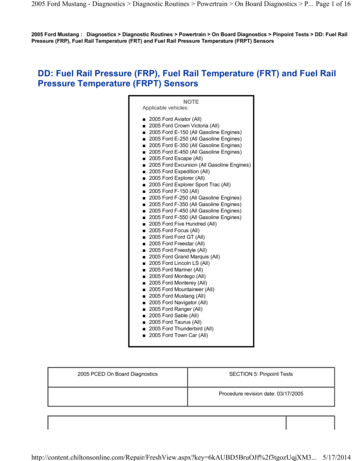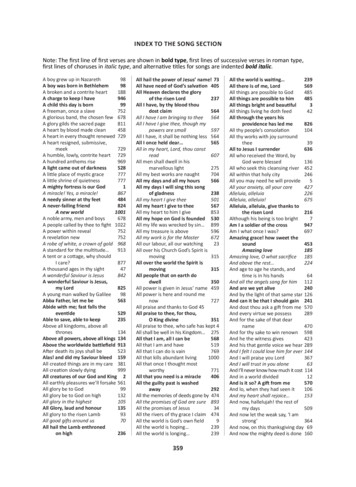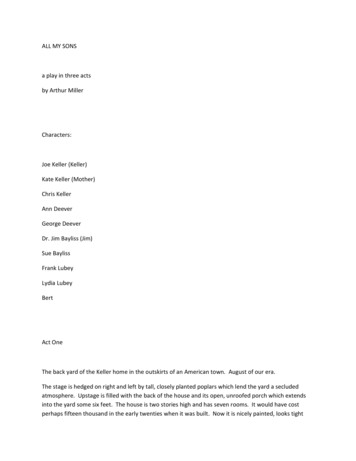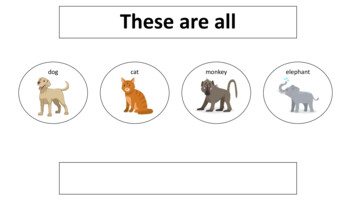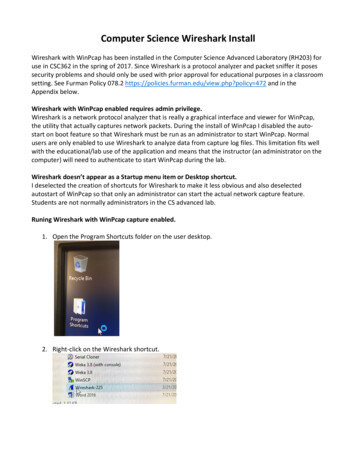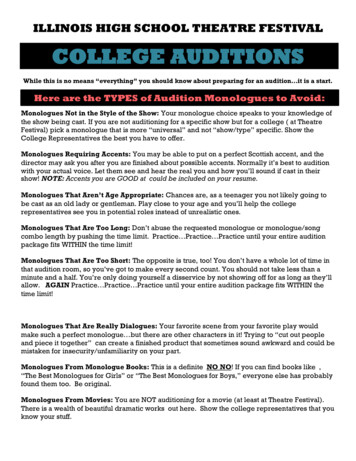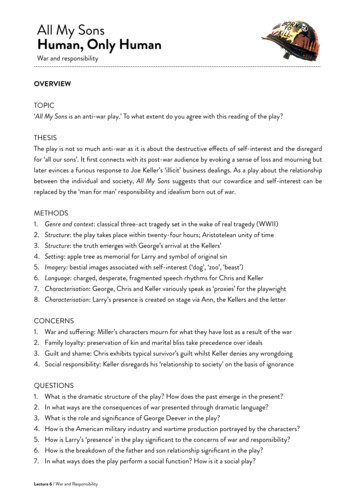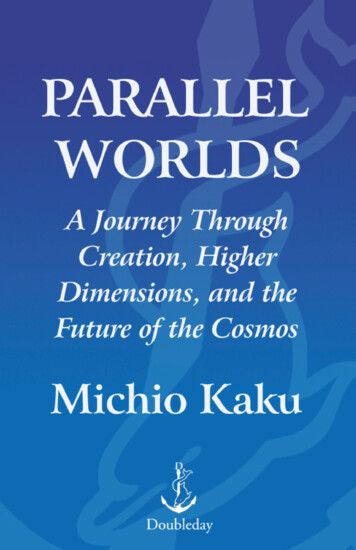
Transcription
Kaku 0385509863 4p all r1.qxd 10/27/04 7:07 AM Page iPARALLELWORLDS
Kaku 0385509863 4p all r1.qxd 10/27/04 7:07 AM Page iiThis book has been optimized for viewingat a monitor setting of 1024 x 768 pixels.
Kaku 0385509863 4p all r1.qxd 10/27/04 7:07 AM Page iiiAlso by Michio KakuBeyond EinsteinHyperspaceVisionsEinstein’s Cosmos
Kaku 0385509863 4p all r1.qxd 10/27/04 7:07 AM Page ivMICHIO KAKUDOUBLEDAYNew York London Toronto Sydney Auckland
Kaku 0385509863 4p all r1.qxd 10/27/04 7:07 AM Page vPARALLELWORLDSA JOURNEY THROUGHCREATION, HIGHER DIMENSIONS,AND THE FUTURE OF THE COSMOS
Kaku 0385509863 4p all r1.qxd 10/27/04 7:07 AM Page vipublished by doubledaya division of Random House, Inc.doubleday and the portrayal of an anchor with a dolphin are registered trademarks of Random House, Inc.Book design by Nicola FergusonIllustrations by Hadel StudioLibrary of Congress Cataloging-in-Publication DataKaku, Michio.Parallel worlds : a journey through creation, higher dimensions,and the future of the cosmos/Michio Kaku.—1st ed.p. cm.Includes bibliographical references1. Cosmology. 2. Big bang theory. 3. Superstring theories.4. Supergravity. I. Title.QB981.K134 2004523.1—dc222004056039eISBN 0-385-51416-6Copyright 2005 Michio KakuAll Rights Reservedv1.0
Kaku 0385509863 4p all r1.qxd 10/27/04 7:07 AM Page viiThis book is dedicated to my loving wife, Shizue.
Kaku 0385509863 4p all r1.qxd 10/27/04 7:07 AM Page viii
Kaku 0385509863 4p all r1.qxd 10/27/04 7:07 AM Page ixCONTENTSacknowledgmentsxiprefacexvPART I: THE UNIVERSEchapter one: Baby Pictures of the Universe3chapter two: The Paradoxical Universe22chapter three: The Big Bang45chapter four: Inflation and Parallel Universes76PART II: THE MULTIVERSEchapter five: Dimensional Portals and Time Travel111chapter six: Parallel Quantum Universes146chapter seven: M-Theory: The Mother of All Strings181chapter eight: A Designer Universe?241chapter nine: Searching for Echoes fromthe Eleventh Dimension256PART III: ESCAPE INTO HYPERSPACEchapter ten: The End of Everything287chapter eleven: Escaping the Universe304chapter twelve: Beyond the Multiverse343notes363glossary381recommended reading403index407
Kaku 0385509863 4p all r1.qxd 10/27/04 7:07 AM Page x
Kaku 0385509863 4p all r1.qxd 10/27/04 7:07 AM Page xiACKNOWLEDGMENTSI would like to thank the following scientists who were so graciousin donating their time to be interviewed. Their comments, observations, and ideas have greatly enriched this book and added to itsdepth and focus: Steven Weinberg, Nobel laureate, University of Texas at Austin Murray Gell-Mann, Nobel laureate, Santa Fe Institute andCalifornia Institute of Technology Leon Lederman, Nobel laureate, Illinois Institute of Technology Joseph Rotblat, Nobel laureate, St. Bartholomew’s Hospital (retired) Walter Gilbert, Nobel laureate, Harvard University Henry Kendall, Nobel laureate, Massachusetts Institute ofTechnology (deceased) Alan Guth, physicist, Massachusetts Institute of Technology Sir Martin Rees, Astronomer Royal of Great Britain, CambridgeUniversity Freeman Dyson, physicist, Institute for Advanced Study,Princeton University John Schwarz, physicist, California Institute of Technology Lisa Randall, physicist, Harvard University J. Richard Gott III, physicist, Princeton University Neil de Grasse Tyson, astronomer, Princeton University andHayden Planetarium Paul Davies, physicist, University of Adelaide Ken Croswell, astronomer, University of California, Berkeley Don Goldsmith, astronomer, University of California, Berkeley Brian Greene, physicist, Columbia University
Kaku 0385509863 4p all r1.qxd 10/27/04 7:07 AM Page xiiACKNOWLEDGMENTSxii Cumrun Vafa, physicist, Harvard UniversityStuart Samuel, physicist, University of California, BerkeleyCarl Sagan, astronomer, Cornell University (deceased)Daniel Greenberger, physicist, City College of New YorkV. P. Nair, physicist, City College of New YorkRobert P. Kirshner, astronomer, Harvard UniversityPeter D. Ward, geologist, University of WashingtonJohn Barrow, astronomer, University of SussexMarcia Bartusiak, science journalist, Massachusetts Instituteof TechnologyJohn Casti, physicist, Santa Fe InstituteTimothy Ferris, science journalistMichael Lemonick, science writer, Time magazineFulvio Melia, astronomer, University of ArizonaJohn Horgan, science journalistRichard Muller, physicist, University of California, BerkeleyLawrence Krauss, physicist, Case Western Reserve UniversityTed Taylor, atomic bomb designerPhilip Morrison, physicist, Massachusetts Institute of TechnologyHans Moravec, computer scientist, Carnegie Mellon UniversityRodney Brooks, computer scientist, Artificial IntelligenceLaboratory, Massachusetts Institute of TechnologyDonna Shirley, astrophysicist, Jet Propulsion LaboratoryDan Wertheimer, astronomer, SETI@home, University ofCalifornia, BerkeleyPaul Hoffman, science journalist, Discover magazineFrancis Everitt, physicist, Gravity Probe B, Stanford UniversitySidney Perkowitz, physicist, Emory UniversityI would also like to thank the following scientists for stimulatingdiscussions about physics over the years that have greatly helped tosharpen the content of this book: T. D. Lee, Nobel laureate, Columbia University Sheldon Glashow, Nobel laureate, Harvard University
Kaku 0385509863 4p all r1.qxd 10/27/04 7:07 AM Page xiiiACKNOWLEDGMENTSxiii Richard Feynman, Nobel laureate, California Institute of Technology (deceased) Edward Witten, physicist, Institute for Advanced Study,Princeton University Joseph Lykken, physicist, Fermilab David Gross, physicist, Kavli Institute, Santa Barbara Frank Wilczek, physicist, University of California, Santa Barbara Paul Townsend, physicist, Cambridge University Peter Van Nieuwenhuizen, physicist, State University of NewYork, Stony Brook Miguel Virasoro, physicist, University of Rome Bunji Sakita, physicist, City College of New York (deceased) Ashok Das, physicist, University of Rochester Robert Marshak, physicist, City College of New York (deceased) Frank Tipler, physicist, Tulane University Edward Tryon, physicist, Hunter College Mitchell Begelman, astronomer, University of ColoradoI would like to thank Ken Croswell for numerous comments onthe book.I would also like to thank my editor, Roger Scholl, who has masterfully edited two of my books. His sure hand has greatly enhancedthe books, and his comments have always helped to clarify anddeepen the content and presentation of my books. Last, I would liketo thank my agent, Stuart Krichevsky, who has ushered in my booksfor all these years.
Kaku 0385509863 4p all r1.qxd 10/27/04 7:07 AM Page xiv
Kaku 0385509863 4p all r1.qxd 10/27/04 7:07 AM Page xvP R E FA C ECosmology is the study of the universe as a whole, including its birthand perhaps its ultimate fate. Not surprisingly, it has undergonemany transformations in its slow, painful evolution, an evolution often overshadowed by religious dogma and superstition.The first revolution in cosmology was ushered in by the introduction of the telescope in the 1600s. With the aid of the telescope,Galileo Galilei, building on the work of the great astronomersNicolaus Copernicus and Johannes Kepler, was able to open up thesplendor of the heavens for the first time to serious scientific investigation. The advancement of this first stage of cosmology culminated in the work of Isaac Newton, who finally laid down thefundamental laws governing the motion of the celestial bodies.Instead of magic and mysticism, the laws of heavenly bodies werenow seen to be subject to forces that were computable and reproducible.A second revolution in cosmology was initiated by the introduction of the great telescopes of the twentieth century, such as the oneat Mount Wilson with its huge 100-inch reflecting mirror. In the1920s, astronomer Edwin Hubble used this giant telescope to overturn centuries of dogma, which stated that the universe was staticand eternal, by demonstrating that the galaxies in the heavens aremoving away from the earth at tremendous velocities—that is, theuniverse is expanding. This confirmed the results of Einstein’s theory of general relativity, in which the architecture of space-time, instead of being flat and linear, is dynamic and curved. This gave thefirst plausible explanation of the origin of the universe, that theuniverse began with a cataclysmic explosion called the “big bang,”
Kaku 0385509863 4p all r1.qxd 10/27/04 7:07 AM Page xvixviP R E FA C Ewhich sent the stars and galaxies hurtling outward in space. Withthe pioneering work of George Gamow and his colleagues on the bigbang theory and Fred Hoyle on the origin of the elements, a scaffolding was emerging giving the broad outlines of the evolution ofthe universe.A third revolution is now under way. It is only about five yearsold. It has been ushered in by a battery of new, high-tech instruments, such as space satellites, lasers, gravity wave detectors, X-raytelescopes, and high-speed supercomputers. We now have the mostauthoritative data yet on the nature of the universe, including itsage, its composition, and perhaps even its future and eventualdeath.Astronomers now realize that the universe is expanding in a runaway mode, accelerating without limit, becoming colder and colderwith time. If this continues, we face the prospect of the “big freeze,”when the universe is plunged into darkness and cold, and all intelligent life dies out.This book is about this third great revolution. It differs from myearlier books on physics, Beyond Einstein and Hyperspace, which helpedto introduce to the public the new concepts of higher dimensionsand superstring theory. In Parallel Worlds, instead of focusing onspace-time, I concentrate on the revolutionary developments in cosmology unfolding within the last several years, based on new evidence from the world’s laboratories and the outermost reaches ofspace, and new breakthroughs in theoretical physics. It is my intention that it can be read and grasped without any previous introduction to physics or cosmology.In part 1 of the book, I focus on the study of the universe, summarizing the advances made in the early stages of cosmology, culminating in the theory called “inflation,” which gives us the mostadvanced formulation to date of the big bang theory. In part 2, I focus specifically on the emerging theory of the multiverse—a worldmade up of multiple universes, of which ours is but one—and discuss the possibility of wormholes, space and time warps, and howhigher dimensions might connect them. Superstring theory andM-theory have given us the first major step beyond Einstein’s origi-
Kaku 0385509863 4p all r1.qxd 10/27/04 7:07 AM Page xviiP R E FA C Exviinal theory; they give further evidence that our universe may be butone of many. Finally, in part 3, I discuss the big freeze and what scientists now see as the end of our universe. I also give a serious,though speculative, discussion of how an advanced civilization inthe distant future might use the laws of physics to leave our universe trillions of years from now and enter another, more hospitableuniverse to begin the process of rebirth, or to go back in time whenthe universe was warmer.With the flood of new data we are receiving today, with new toolssuch as space satellites which can scan the heavens, with new gravity wave detectors, and with new city-size atom smashers nearingcompletion, physicists feel that we are entering what may be thegolden age of cosmology. It is, in short, a great time to be a physicistand a voyager on this quest to understand our origins and the fate ofthe universe.
Kaku 0385509863 4p all r1.qxd 10/27/04 7:07 AM Page xviii
Kaku 0385509863 4p all r1.qxd 10/27/04 7:07 AM Page 1PARTONETHE UNIVERSE
Kaku 0385509863 4p all r1.qxd 10/27/04 7:07 AM Page 2
Kaku 0385509863 4p all r1.qxd 10/27/04 7:07 AM Page 3CHAPTER ONEBaby Pictures of the UniverseThe poet only asks to get his head into the heavens. It isthe logician who seeks to get the heavens into his head.And it is his head that splits.—G. K. ChestersonWhen I was a child, I had a personal conflict over my beliefs. Myparents were raised in the Buddhist tradition. But I attendedSunday school every week, where I loved hearing the biblical storiesabout whales, arks, pillars of salt, ribs, and apples. I was fascinatedby these Old Testament parables, which were my favorite part ofSunday school. It seemed to me that the parables about great floods,burning bushes, and parting waters were so much more excitingthan Buddhist chanting and meditation. In fact, these ancient talesof heroism and tragedy vividly illustrated deep moral and ethicallessons which have stayed with me all my life.One day in Sunday school we studied Genesis. To read about Godthundering from the heavens, “Let there be Light!” sounded so muchmore dramatic than silently meditating about Nirvana. Out of naïvecuriosity, I asked my Sunday school teacher, “Did God have amother?” She usually had a snappy answer, as well as a deep morallesson to offer. This time, however, she was taken aback. No, shereplied hesitantly, God probably did not have a mother. “But then
Kaku 0385509863 4p all r1.qxd 10/27/04 7:07 AM Page 44Michio Kakuwhere did God come from?” I asked. She mumbled that she wouldhave to consult with the minister about that question.I didn’t realize that I had accidentally stumbled on one of thegreat questions of theology. I was puzzled, because in Buddhism,there is no God at all, but a timeless universe with no beginning orend. Later, when I began to study the great mythologies of the world,I learned that there were two types of cosmologies in religion, thefirst based on a single moment when God created the universe, thesecond based on the idea that the universe always was and alwayswill be.They couldn’t both be right, I thought.Later, I began to find that these common themes cut across manyother cultures. In Chinese mythology, for example, in the beginningthere was the cosmic egg. The infant god P’an Ku resided for almostan eternity inside the egg, which floated on a formless sea of Chaos.When it finally hatched, P’an Ku grew enormously, over ten feet perday, so the top half of the eggshell became the sky and the bottomhalf the earth. After 18,000 years, he died to give birth to our world:his blood became the rivers, his eyes the sun and moon, and his voicethe thunder.In many ways, the P’an Ku myth mirrors a theme found in manyother religions and ancient mythologies, that the universe spranginto existence creatio ex nihilo (created from nothing). In Greekmythology, the universe started off in a state of Chaos (in fact, theword “chaos” comes from the Greek word meaning “abyss”). This featureless void is often described as an ocean, as in Babylonian andJapanese mythology. This theme is found in ancient Egyptianmythology, where the sun god Ra emerged from a floating egg. InPolynesian mythology, the cosmic egg is replaced by a coconut shell.The Mayans believed in a variation of this story, in which the universe is born but eventually dies after five thousand years, only to beresurrected again and again to repeat the unending cycle of birthand destruction.These creatio ex nihilo myths stand in marked contrast to the cosmology according to Buddhism and certain forms of Hinduism. Inthese mythologies, the universe is timeless, with no beginning or
Kaku 0385509863 4p all r1.qxd 10/27/04 7:07 AM Page 5PA R A L L E L W O R L D S5end. There are many levels of existence, but the highest is Nirvana,which is eternal and can be attained only by the purest meditation.In the Hindu Mahapurana, it is written, “If God created the world,where was He before Creation? . . . Know that the world is uncreated, as time itself is, without beginning and end.”These mythologies stand in marked contradiction to each other,with no apparent resolution between them. They are mutually exclusive: either the universe had a beginning or it didn’t. There is, apparently, no middle ground.Today, however, a resolution seems to be emerging from an entirely new direction—the world of science—as the result of a newgeneration of powerful scientific instruments soaring through outerspace. Ancient mythology relied upon the wisdom of storytellers toexpound on the origins of our world. Today, scientists are unleashing a battery of space satellites, lasers, gravity wave detectors, interferometers, high-speed supercomputers, and the Internet, in theprocess revolutionizing our understanding of the universe, and giving us the most compelling description yet of its creation.What is gradually emerging from the data is a grand synthesisof these two opposing mythologies. Perhaps, scientists speculate,Genesis occurs repeatedly in a timeless ocean of Nirvana. In thisnew picture, our universe may be compared to a bubble floating ina much larger “ocean,” with new bubbles forming all the time.According to this theory, universes, like bubbles forming in boilingwater, are in continual creation, floating in a much larger arena, theNirvana of eleven-dimensional hyperspace. A growing number ofphysicists suggest that our universe did indeed spring forth from afiery cataclysm, the big bang, but that it also coexists in an eternalocean of other universes. If we are right, big bangs are taking placeeven as you read this sentence.Physicists and astronomers around the world are now speculating about what these parallel worlds may look like, what laws theymay obey, how they are born, and how they may eventually die.Perhaps these parallel worlds are barren, without the basic ingredients of life. Or perhaps they look just like our universe, separated bya single quantum event that made these universes diverge from
Kaku 0385509863 4p all r1.qxd 10/27/04 7:07 AM Page 66Michio Kakuours. And a few physicists are speculating that perhaps one day, iflife becomes untenable in our present universe as it ages and growscold, we may be forced to leave it and escape to another universe.The engine driving these new theories is the massive flood of datathat is pouring from our space satellites as they photograph remnants of creation itself. Remarkably, scientists are now zeroing in onwhat happened a mere 380,000 years after the big bang, when the“afterglow” of creation first filled the universe. Perhaps the mostcompelling picture of this radiation from creation is coming from anew instrument called the WMAP satellite.THE WMAP SATELLITE“Incredible!” “A milestone!” were among the words uttered inFebruary 2003 by normally reserved astrophysicists as they described the precious data harvested from their latest satellite. TheWMAP (Wilkinson microwave anisotropy probe), named after pioneering cosmologist David Wilkinson and launched in 2001, hasgiven scientists, with unprecedented precision, a detailed picture ofthe early universe when it was a mere 380,000 years old. The colossal energy left over from the original fireball that gave birth to starsand galaxies has been circulating around our universe for billions ofyears. Today, it has finally been captured on film in exquisite detailby the WMAP satellite, yielding a map never seen before, a photo ofthe sky showing with breathtaking detail the microwave radiationcreated by the big bang itself, what has been called the “echo of creation” by Time magazine. Never again will astronomers look at thesky in the same way again.The findings of the WMAP satellite represent “a rite of passagefor cosmology from speculation to precision science,” declared JohnBahcall of the Institute for Advanced Study at Princeton. For thefirst time, this deluge of data from this early period in the history ofthe universe has allowed cosmologists to answer precisely the mostancient of all questions, questions that have puzzled and intriguedhumanity since we first gazed at the blazing celestial beauty of the
Kaku 0385509863 4p all r1.qxd 10/27/04 7:07 AM Page 7PA R A L L E L W O R L D S7night sky. How old is the universe? What is it made of? What is thefate of the universe?(In 1992, a previous satellite, the COBE [Cosmic BackgroundExplorer satellite] gave us the first blurry pictures of this background radiation filling the sky. Although this result was revolutionary, it was also disappointing because it gave such anout-of-focus picture of the early universe. This did not prevent thepress from excitedly dubbing this photograph “the face of God.” Buta more accurate description of the blurry pictures from COBE wouldbe that they represented a “baby picture” of the infant universe. Ifthe universe today is an eighty-year-old man, the COBE, and laterthe WMAP, pictures showed him as a newborn, less than a day old.)The reason the WMAP satellite can give us unprecedented pictures of the infant universe is that the night sky is like a time machine. Because light travels at a finite speed, the stars we see at nightare seen as they once were, not as they are today. It takes a little overa second for light from the Moon to reach Earth, so when we gaze atthe Moon we actually see it as it was a second earlier. It takes abouteight minutes for light to travel from the Sun to Earth. Likewise,many of the familiar stars we see in the heavens are so distant thatit takes from 10 to 100 years for their light to reach our eyes. (Inother words, they lie 10 to 100 light-years from Earth. A light-year isroughly 6 trillion miles, or the distance light travels in a year.) Lightfrom the distant galaxies may be hundreds of millions to billions oflight-years away. As a result, they represent “fossil” light, some emitted even before the rise of the dinosaurs. Some of the farthest objectswe can see with our telescopes are called quasars, huge galactic engines generating unbelievable amounts of power near the edge of thevisible universe, which can lie up to 12 to 13 billion light-years fromEarth. And now, the WMAP satellite has detected radiation emittedeven before that, from the original fireball that created the universe.To describe the universe, cosmologists sometimes use the exampleof looking down from the top of the Empire State Building, whichsoars more than a hundred floors above Manhattan. As you look downfrom the top, you can barely see the street level. If the base of the
Kaku 0385509863 4p all r1.qxd 10/27/04 7:07 AM Page 88Michio KakuEmpire State Building represents the big bang, then, looking downfrom the top, the distant galaxies would be located on the tenth floor.The distant quasars seen by Earth telescopes would be on the seventhfloor. The cosmic background measured by the WMAP satellite wouldbe just half an inch above the street. And now the WMAP satellite hasgiven us the precise measurement of the age of the universe to an astonishing 1 percent accuracy: 13.7 billion years.The WMAP mission is the culmination of over a decade of hardwork by astrophysicists. The concept of the WMAP satellite was firstproposed to NASA in 1995 and was approved two years later. On June30, 2001, NASA sent the WMAP satellite aboard a Delta II rocket intoa solar orbit perched between Earth and the Sun. The destinationwas carefully chosen to be the Lagrange point 2 (or L2, a special pointof relative stability near Earth). From this vantage point, the satellite always points away from the Sun, Earth, and Moon and hencehas a totally unobstructed view of the universe. It completely scansthe entire sky every six months.Its instrumentation is state-of-the-art. With its powerful sensors,it can detect the faint microwave radiation left over from the bigbang that bathes the universe, but is largely absorbed by our atmosphere. The aluminum-composite satellite measures 3.8 meters by 5meters (about 11.4 feet by 15 feet) and weighs 840 kilograms (1,850pounds). It has two back-to-back telescopes that focus the microwaveradiation from the surrounding sky, and eventually it radios thedata back to Earth. It is powered by just 419 watts of electricity (thepower of five ordinary lightbulbs). Sitting a million miles fromEarth, the WMAP satellite is well above Earth’s atmospheric disturbances, which can mask the faint microwave background, and it isable to get continuous readings of the entire sky.The satellite completed its first observation of the full sky inApril 2002. Six months later, the second full sky observation wasmade. Today, the WMAP satellite has given us the most comprehensive, detailed map of this radiation ever produced. The backgroundmicrowave radiation the WMAP detected was first predicted byGeorge Gamow and his group in 1948, who also noted that this radiation has a temperature associated with it. The WMAP measured this
Kaku 0385509863 4p all r1.qxd 10/27/04 7:07 AM Page 9PA R A L L E L W O R L D S9temperature to be just above absolute zero, or between 2.7249 to2.7251 degrees Kelvin.To the unaided eye, the WMAP map of the sky looks rather uninteresting; it is just a collection of random dots. However, this collection of dots has driven some astronomers almost to tears, for theyrepresent fluctuations or irregularities in the original, fiery cataclysm of the big bang shortly after the universe was created. Thesetiny fluctuations are like “seeds” that have since expanded enormously as the universe itself exploded outward. Today, these tinyseeds have blossomed into the galactic clusters and galaxies we seelighting up the heavens. In other words, our own Milky Way galaxyand all the galactic clusters we see around us were once one of thesetiny fluctuations. By measuring the distribution of these fluctuations, we see the origin of the galactic clusters, like dots painted onthe cosmic tapestry that hangs over the night sky.Today, the volume of astronomical data is outpacing scientists’ theories. In fact, I would argue that we are entering a golden age of cosmology. (As impressive as the WMAP satellite is, it will likely beThis is a “baby picture” of the universe, as it was when it was only 380,000years old, taken by the WMAP satellite. Each dot most likely represents a tinyquantum fluctuation in the afterglow of creation that has expanded to createthe galaxies and galactic clusters we see today.
Kaku 0385509863 4p all r1.qxd 10/27/04 7:07 AM Page 1010Michio Kakudwarfed by the Planck satellite, which the Europeans are launching in2007; the Planck will give astronomers even more detailed pictures ofthis microwave background radiation.) Cosmology today is finally coming of age, emerging from the shadows of science after languishing foryears in a morass of speculation and wild conjecture. Historically, cosmologists have suffered from a slightly unsavory reputation. The passion with which they proposed grandiose theories of the universe wasmatched only by the stunning poverty of their data. As Nobel laureateLev Landau used to quip, “cosmologists are often in error but never indoubt.” The sciences have an old adage: “There’s speculation, thenthere’s more speculation, and then there’s cosmology.”As a physics major at Harvard in the late 1960s, I briefly toyedwith the possibility of studying cosmology. Since childhood, I’ve always had a fascination with the origin of the universe. However, aquick glance at the field showed that it was embarrassingly primitive. It was not an experimental science at all, where one can testhypotheses with precise instruments, but rather a collection ofloose, highly speculative theories. Cosmologists engaged in heateddebates about whether the universe was born in a cosmic explosionor whether it has always existed in a steady state. But with so littledata, the theories quickly outpaced the data. In fact, the less thedata, the fiercer the debate.Throughout the history of cosmology, this paucity of reliable dataalso led to bitter, long-standing feuds between astronomers, whichoften raged for decades. (For example, just before astronomer AllanSandage of the Mount Wilson Observatory was supposed to give atalk about the age of the universe, the previous speaker announcedsarcastically, “What you will hear next is all wrong.” And Sandage,hearing of how a rival group had generated a great deal of publicity,would roar, “That’s a bunch of hooey. It’s war—it’s war!”)THE AGE OF THE UNIVERSEAstronomers have been especially keen to know the age of the universe. For centuries, scholars, priests, and theologians have tried to
Kaku 0385509863 4p all r1.qxd 10/27/04 7:07 AM Page 11PA R A L L E L W O R L D S11estimate the age of the universe using the only method at their disposal: the genealogy of humanity since Adam and Eve. In the lastcentury, geologists have used the residual radiation stored in rocksto give the best estimate of the age of Earth. In comparison, theWMAP satellite today has measured the echo of the big bang itself togive us the most authoritative age of the universe. The WMAP datareveals that the universe was born in a fiery explosion that tookplace 13.7 billion years ago.(Over the years, one of the most embarrassing facts plaguing cosmology has been that the age of the universe was often computed tobe younger than the age of the planets and stars, due to faulty data.Previous estimates for the age of the universe were as low as 1 to 2billion years, which contradicted the age of Earth [4.5 billion years]and the oldest stars [12 billion years]. These contradictions have nowbeen eliminated.)The WMAP has added a new, bizarre twist to the debate over whatthe universe is made of, a question that the Greeks asked over twothousand years ago. For the past century, scientists believed thatthey knew the answer to this question. After thousands of painstaking experiments, scientists had concluded that the universe was basically made of about a hundred different types of atoms, arranged inan orderly periodic chart, beginning with elemental hydrogen. Thisforms the basis of modern chemistry and is, in fact, taught in everyhigh school science class. The
Einstein’s Cosmos Kaku_0385509863_4p_all_r1.qxd 10/27/04 7:07 AM Page iii. MICHIO KAKU DOUBLEDAY New York London Toronto Sydney Auckland Kaku_0385509863_4p_all_r1.qxd 10/27/04 7:07 AM Page iv. PARALLEL WORLDS A JOURNEY THROUGH CREATION, HIGHER

